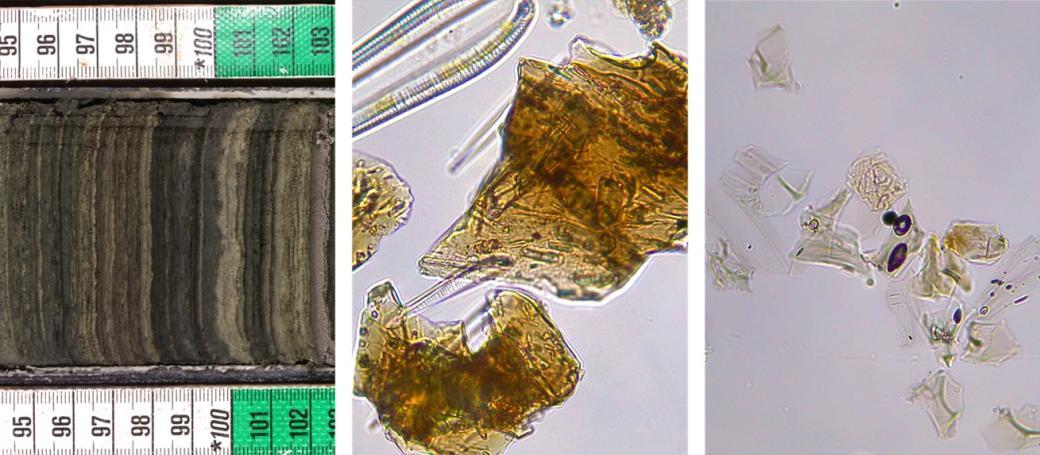
Lead supervisor: Christine Lane, Geography
Co-supervisor: Celine Vidal, Geography
Brief summary:
Carry out a cryptotephra study of the exquisitely laminated Lake Chala sediment record, aiming to improve regional chronologies for regional Late Pleistocene palaeoclimate, archaeological and volcanic studies.
Importance of the area of research concerned:
Volcanic ash (tephra) layers are a key tool for dating and correlating palaeoenvironmental, archaeological and volcanic records, allowing the transfer of proxy and chronological data between diverse archives. Along the East African Rift (EAR) voluminous and widespread tephra layers occur frequently in Middle and Late Stone Age sequences. Whilst few are correlated to a volcanic source, they have provided age constraints for the biological and behavioural evolution of our species (Blegen et al., 2021). Tephra are also preserved in stratigraphic order within many lake sediment archives that contain valuable palaeoenvironmental datasets. However, the potential to detail volcanic histories, improve chronologies for sediment sequences and correlate lake sediment proxy-based environmental reconstructions with the regional archaeological records along the EAR, is only recently being realised (Martin-Jones et al., 2020; Vidal et al., 2022). This project will support the construction of a regional Late Pleistocene tephrostratigraphy through the detection of key widespread tephra horizons preserved in the sediment record of Lake Chala, a crater lake on the border of Kenya and Tanzania.
Project summary :
The project advances prior tephra research on the 250 kyr -long Lake Chala archive, by examining the pre-Holocene tephra record. Visible tephra have been described, but laboratory detection of microscopic cryptotephra through the Holocene portion of the core, which holds 2 visible tephra layers, identified 28 new horizons. Chala’s tephra record documents local off-rift volcanism and includes regional markers found in geoarchaeological sequences (Martin-Jones et al., 2020; Blegen et al., 2021). Extending the level of detail down-core, through targeted cryptotephra searches aims to: i. improve the chronology of the Lake Chala record; ii. anchor the Lake Chala palaeoclimate record to archaeological sequences, to explore the role of climate change on hominin behavioural evolution; iii. detail explosive eruption histories for volcanoes in the Kenyan and Northern Tanzania branches of the EARS.
What will the student do?:
The student will identify intervals and events of interest within the Late Pleistocene, for example, the East African Megadroughts period, the Middle to Late Stone Age transition, or significant volcanic events, and carry out targeted cryptotephra investigations on the Lake Chala cores. They will work in the Cambridge Tephra Laboratory to detect cryptotephra, which they will geochemically characterise and correlate to far-travelled tephra deposits.
Geochemical characterisation of tephra will utilise wavelength dispersive electron microscopy and laser ablation mass-spectrometry to measure major, minor and trace element glass shard compositions. Large compositional datasets will be generated and compared to available reference materials and data using traditional bi-plotting and statistical methods.
This is largely a lab-based project, however there could be opportunities for fieldwork – either to visit Lake Chala, or to sample key tephra sequences to generate reference data or make new correlations.
References - references should provide further reading about the project:
Martin‐Jones, C., Lane, C., Van Daele, M., Meeren, T.V.D., Wolff, C., Moorhouse, H., Tomlinson, E. and Verschuren, D., 2020. History of scoria‐cone eruptions on the eastern shoulder of the Kenya–Tanzania Rift revealed in the 250‐ka sediment record of Lake Chala near Mount Kilimanjaro. Journal of Quaternary Science, 35(1-2), pp.245-255.
Blegen, N., Faith, J.T. and Peppe, D.J., 2021. Tephrostratigraphy of the eastern Lake Victoria Basin including the Nyanza Rift, Kenya: Building a stratigraphic and chronological framework for modern human evolution. Quaternary Science Reviews, 256, p.106823.
Vidal, C.M., Lane, C.S., Asrat, A., Barfod, D.N., Mark, D.F., Tomlinson, E.L., Tadesse, A.Z., Yirgu, G., Deino, A., Hutchison, W. and Mounier, A., 2022. Age of the oldest known Homo sapiens from eastern Africa. Nature, 601(7894), pp.579-583.
Applying
You can find out about applying for this project on the Department of Geography page.